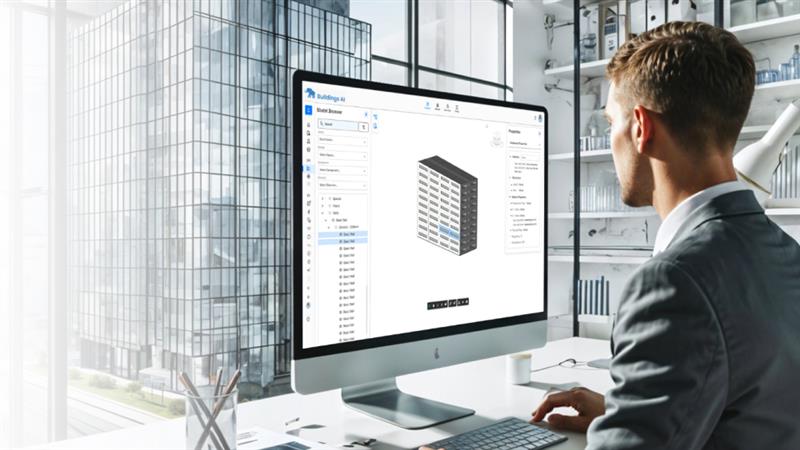Written by Ganesh Gund
Tuesday, April 04, 2023
Ensure Thermal Comfort and IAQ in Office Workspace at the Design Stage
By
Ganesh Gund


The mechanical system design of a new office building is tuned to maximize the quality of the occupant experience, and this presents challenges from a thermal comfort and indoor air quality perspective. Healthy and comfortable indoor environments are essential for occupant satisfaction, well-being, and productivity for people who spend most of their time indoors. In terms of indoor environmental quality, the main components are thermal comfort and indoor air quality, which are primarily controlled by HVAC systems. In this blog, we will explore how autonomous HVAC CFD (AHC) helps to ensure thermal comfort and indoor air quality in office spaces at the design stage.
How do you ensure your office HVAC System is designed correctly before installation?
Designing an HVAC system for large offices is a challenging task that requires careful consideration of various factors, including the size of the building, zoning, air quality, thermal comfort, etc. It should be designed and installed carefully to ensure optimal performance and thermal comfort.
Autonomous HVAC CFD (AHC) is a powerful tool developed by the simulation hub. It helps users to create a large building model based on the floor plan with a sketching tool. Different material properties can be assigned from the library for walls, glass windows, roof/ceiling, and floor. The building site location and orientation are specified, and the users can select occupant seating layouts with manikins, furniture, lights, and office appliances from the BIM. Also create multiple air side systems with different diffusers or A/C units and their supply/return positions to try different air distribution systems like overhead mixing, displacement ventilation, or underfloor air distribution.

Figure 1: 2D Office Workspace BIM Model
The numerical domain considered for the simulations is an office workspace consisting of the following details
- Total Area: 13400 SQFT
- Total Spaces: 9
- Number of Manikin: 302
- HVAC System Used: Hybrid HVAC System

Figure 2: 3D Office Workspace BIM Model
Is Your Office Workspace Too Hot, Too Cold, or Making You Sick?
The American Society of Heating, Refrigerating, and Air-Conditioning Engineers (ASHRAE) recommends a temperature range for office work of 72°F to 80°F in the summer and, 68°F -74°F in the winter with a relative humidity range of 30-60% and an air velocity of 50 fpm for cooling and 30 fpm for heating. This range is intended to provide thermal comfort for the majority of people, and HVAC systems are responsible for maintaining these indoor air conditions. It is established that a change of 15 fpm in air velocity produces approximately the same effect on comfort as a 1°F change in temperature.
Utilizing Autonomous HVAC CFD (AHC) at the design stage can be a highly effective tool to ensure thermal comfort and indoor air quality. Simulations can help designers analyze and optimize HVAC systems, and the placement of air outlets and inlets to achieve optimal air distribution and thermal comfort for occupants. Designers can identify potential problems such as areas of stagnant air, high-velocity airflows, and areas with poor air quality and troubleshoot potential issues before installation.

Figure 3: Thermal Comfort Prediction

Figure 4: Temperature Contour

Figure 5: Relative Humidity Contour

Figure 6: Velocity Contour
Do You Know What You're Breathing In?
Carbon dioxide (CO2) concentration in office spaces is important for maintaining good indoor air quality and occupant health and productivity. It was found that moderate increases in the indoor CO2 level between 550 and 950 ppm adversely affected the cognitive performance of office workers. When concentrations exceed 1000 ppm, discomfort symptoms such as nausea, dizziness, and fatigue occur. One way to reduce concentration is to regulate the HVAC system, but improper ventilation will lead to a significant accumulation of CO2 and negative health effects. It is necessary to ensure and provide minimum ventilation requirements by the HVAC system to dilute the concentration and maintain satisfactory indoor environments.
Autonomous HVAC CFD (AHC) helps to predict CO2 concentrations in office spaces by simulating the CO2 dispersion in the supply air, return air, and breathing zone. Also, it ensures that the minimum ventilation requirement is fulfilled or not, as specified in ASHRAE 62.1-2022, to maintain acceptable indoor air quality. It can take into account various factors such as the building geometry, HVAC system design and operation, occupancy patterns, outdoor weather conditions, and CO2 ppm level.

Figure 7: Areas of Indoor Acceptable level (400 < ppm < 1000)

Figure 8: CO2 Concentration Graph
Ultimately, utilizing AHC at the design stage can lead to better-performing and more comfortable office workspaces, happier and healthier employees, and a more sustainable workplace.
What types of simulations and assessments can be performed using Autonomous HVAC CFD?
- Predicts the thermal comfort and indoor air quality at the design stage.
- Ensure the occupant's thermal comfort complies with ASHRAE 55-2020.
- Local thermal discomfort parameters such as draft rate, Vertical Air Temperature Difference, Radiant Temperature Asymmetry, Mean Radiant Temperature, etc.
- Validate the ventilation strategies to achieve healthy CO2 levels in indoor spaces.
- Air Distribution System Study for Constant Air Volume (CAV), Variable Air Volume (VAV), Underfloor Air Distribution (UFAD), and Displacement and Mixing Ventilation Systems
- Performance parameters assessment such as air distribution performance index (ADPI) and air change effectiveness (ACE)
Reference
- ANSI/ASHRAE 55-2020, Thermal environmental conditions for human occupancy
- ANSI/ASHRAE 62.1-2022, Ventilation and acceptable indoor air quality
- Titus engineering guidelines basic principles of air distribution
Get your FREE trial
Wish to explore Autonomous HVAC CFD to optimize your HVAC design for IAQ and thermal? Sign-up now and get free credits worth $500 for 90 days. You can explore the product and evaluate HVAC designs for Indoor Air Quality and estimate thermal comfort upto space area of 5000 square feet.
Comments
Recent posts


